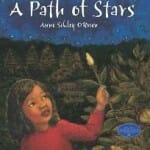 I returned a large stack of picture books and stood motionless in the library lobby. I looked toward the children’s section. What was I going to look for next? Hmm.
I returned a large stack of picture books and stood motionless in the library lobby. I looked toward the children’s section. What was I going to look for next? Hmm.
Should I search for more Indian books or should I switch my focus?
Where would I begin if I changed ethnic groups? I wasn’t sure?
Then I eyed some shelves labeled “new picture books”. I sat on the floor and started to take picture walks. Before I knew it, I had a pile of books that appeared to fall within the genre of multiculturalism. I checked the books out and went home.
I looked at the cover of A Path of Stars. It was written and illustrated by Anne Sibley O’Brien. It was indeed new. It had a copyright date of 2012. I questioned the authenticity. Could a woman with the name O’Brien write effectively about life in Cambodia?
Then I saw a small blue emblem that said Maine Humanities Council. An author’s note at the back of the book explained the connection. The Maine Humanities Council asked Anne to write a book about Maine’s Cambodian American community. This organization offers an extensive list of educational services for adults and children and also emphasizes multicultural literature. It is a website worth exploring.
Anne’s childhood was spent in a bilingual environment in South Korea. and as an adult she had illustrated more than 20 picture books. She did not rely on her limited personal experience, but instead did extensive research in order to gain an appreciation and understanding of the Cambodian experience.
Like some of the Indian picture books that I wrote about in the past, this book revolves around the close relationship between a grandparent and a grandchild. This universal theme not only connects Cambodian children with their grandparents, but also appeals to all children who have a relationship with a grandparent. Dialogue between the generations enables the older generation the possibility to pass on information to the younger generation. This theme adds a special touch to the story.
This story is told from the perspective of a child named Dara. She retells some of her grandmother’s tales which provide a rich source of information about Cambodian culture and history. The grandmother’s tales includes information about her family’s escape to Thailand and later to the U.S. Once again, the concept of being a refugee can connect other ethnic groups to this story.
Another thread that is woven into the text is the topic of loss, separation, and death. Anne craftily handles these sensitive topics with compassion. Many children will be able to relate to the grandmother’s desire to be reunited with her brother who remains in Cambodia, the desire to visit her homeland, and the grief she experiences when she learns of her brother’s unexpected death. Dara becomes an excellent role model for children. Her initiative and positive thinking helps her grandmother to overcome her loss.
The delicate messages from the book are captured in Anne’s illustrations. Each was created with oil paint and water soluble oil crayons. The predominance of orange and yellow tones casts a warm feeling throughout the book.
Discussion Topics
- inter-generational relationships (grandchildren and grandparents)
- Cambodian culture and history
- Cambodian foods
- the effects of war
- life as a refugee
- longing to return to a homeland
- study of stars
- Buddhism
- coping with the death of a loved one
Question
- Can you share any other books that relate to the Cambodian American experience?
- If you are a Cambodian American, can you relate to this book?
Leave a Reply
You must be logged in to post a comment.